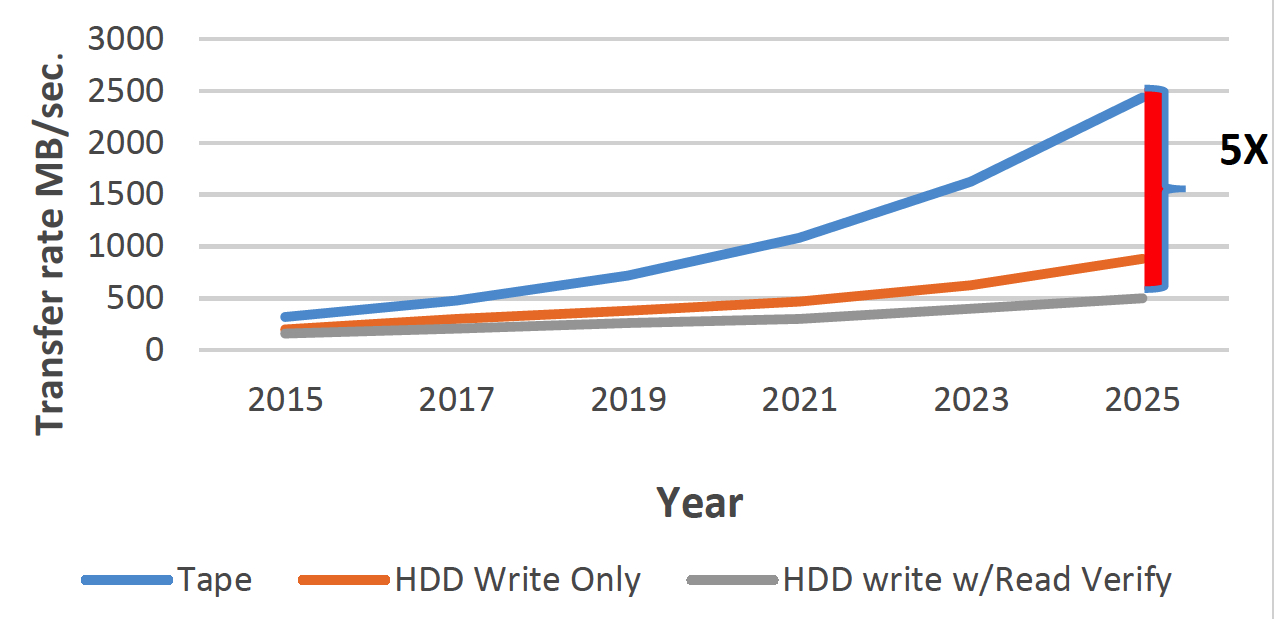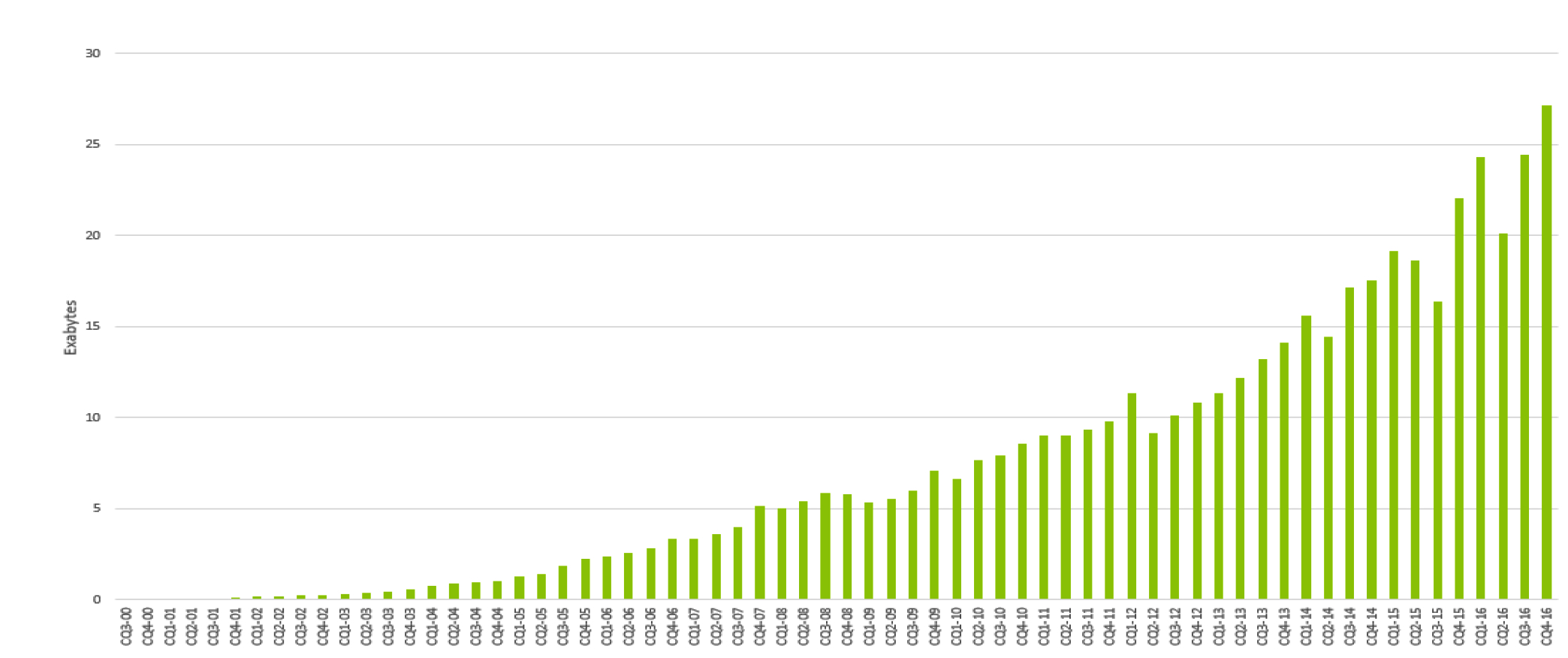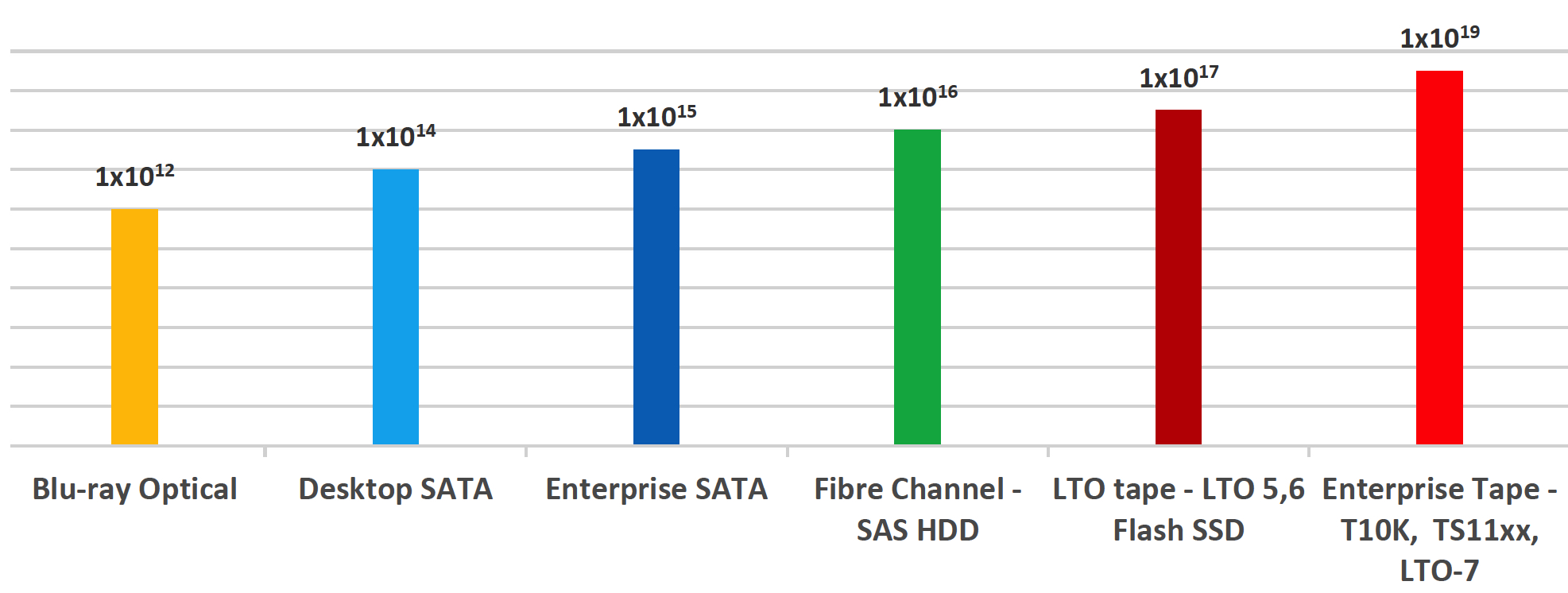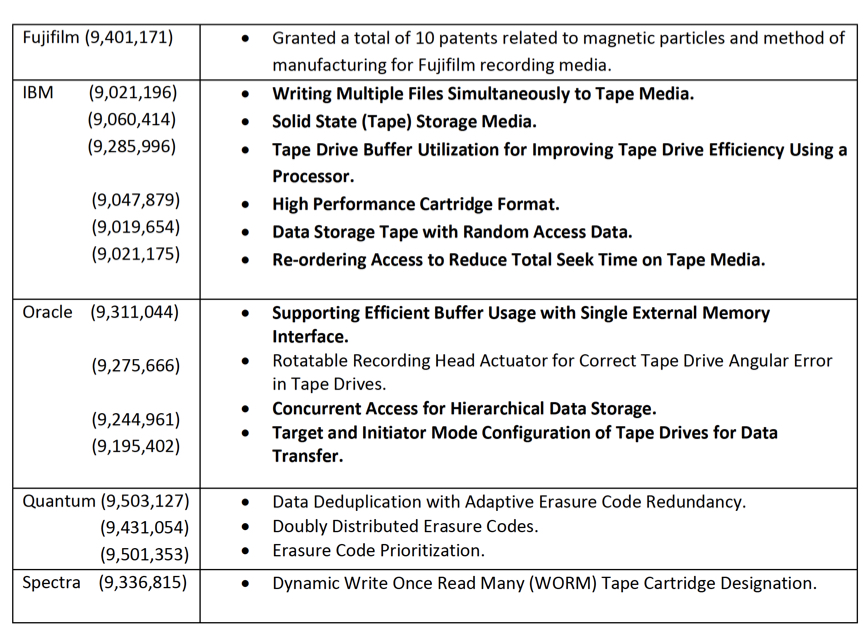Tape Value Proposition Compelling
According to advocacy of Tape Storage Council
This is a Press Release edited by StorageNewsletter.com on April 17, 2017 at 2:46 pmThe Tape Storage Council, which includes representatives of BDT, Frontier BV, FUJIFILM, GazillaByte, Hewlett Packard Enterprise, IBM, Imagine Products, Integra, Iron Mountain, NCE Computer Group, Oracle, Overland Storage, Qualstar, Quantum, REB Storage Systems, Spectra Logic, StrongBox Data Solutions, Tandberg Data, Turtle and XpresspaX has issued the following memo to highlight the current trends, usages and technology innovations occurring within the tape storage industry.
Technology Advances Propel Tape to New Markets
Industry Leading Capacity, Reliability, and Lowest Costs Are Changing the Game
Abstract
Tape expanded its reach in 2016 effectively addressing many data intensive markets including cloud, entertainment, hyperscale data centers, HPC and the Internet along with large-scale data intensive applications such as big data, backup, recovery, long-term archive, DR, government compliance, while positioning for the unknown appetite of the IoT. The tape industry has been fueled by a decade of strong technological development and continues to play a major role for its traditional backup and DR services in addition to effectively addressing many new large-scale storage requirements. Demand for tape is being fueled by unrelenting data growth, significant technological advancements, tape’s highly favorable economics, low energy requirements, and the growing regulatory and business requirements to maintain ‘access to data forever.’ Steady improvements have made tape technology the most reliable storage medium available, now surpassing the reliability of HDDs by three orders of magnitude. Disk technology has been advancing, but tape’s progress over the last ten years has been even greater.
Tape’s Value Proposition is Compelling
Continued development and investment in tape library, drive, media and data management software has effectively addressed the relentless demand for improved reliability, higher capacity, better power efficiency, ease of use and the lowest cost per gigabyte and TCO of any storage solution.
Below is a summary of tape’s value proposition followed by key metrics for each:
• Tape drives have a BER (Bit Error Rate) of 1×1019 bits read, the highest reliability level of any storage device surpassing HDDs at 1×1016 by three orders of magnitude.
• Tape cartridge capacity is on an unprecedented trajectory with areal density projected to grow twice as fast as HDDs for the foreseeable future.
• Tape data rates are expected to be as much as five times faster than HDDs by 2025.
• Tape has a media life exceeding 30 years, longer than any other data center digital storage solution.
• Energy consumption for tape is less than HDDs with some studies showing tape energy consumption less than 2% of HDDs for the equivalent amount of storage.
• For archiving, TCO studies indicate today’s disk based storage solutions are at least six times more costly per terabyte stored than solutions based on tape libraries.
• Tape’s functionality and ease of use is enhanced with LTFS software and widespread HSM support.
Total shipped capacity by calendar quarter
(EB compressed)
Click to enlarge
(Source: LTO Program Techology Provider Companies (TPCs)
In 4Q16 LTO capacity shipments totaled nearly 27EBs (compressed), making it the highest capacity shipped quarter in LTO history. Enterprise tape libraries now scale beyond one exabyte making tape the first exascale storage solution. HPC and hyperscale data centers are racing towards exascale storage requirements.
Reliability. Reliability levels for tape are quickly improving as the BER for both enterprise and LTO-7 tape is rated at one bit in error per 1×1019 bits read. This makes the top-rated tape drives 1,000 times more reliable than the top-rated HDDs at 1×116. The tape BER is most impressive and leads the entire storage industry; expect higher levels of tape reliability going forward. See BER comparative chart below:
Reliability Comparison All Storage devices
(Source: Storage vendor’s published specs)
Capacity and Data Rate. Tape capacities and data rates are growing faster than other storage technologies. LTO-8 plans to deliver 12.8TB native capacity and the next enterprise drives from IBM are aiming for native capacities of 15TB and higher. Tape capacities also benefit from a 2.5x compression boost as most of the data written to tape is compressed whereas most data written to HDDs is not compressed. When comparing native data rates, LTO-7 transfers data at 300MB/s and the TS1150 at 360MB/s which is faster than the typical 7,200rpm HDD at 160MB/s. Tape cartridge capacities and data transfer speeds are expected to grow rapidly for the foreseeable future with no fundamental technology limitations in sight.
Media Life. Media life refers to durability and is often confused with tape reliability. Manufacturer’s specifications indicate that today’s enterprise and LTO tape media has a life span of 30 years or more while a tape drive is typically deployed 7 to 10 years before replacement. By comparison, a standard disk drive is typically operational from 3 to 5 years before replacement. In addition, LTO tape drives can typically read the current version and the two prior LTO versions to minimize the conversion effort.
Energy Consumption. The world’s data centers now consume almost as much energy as the country of Spain and consume just over 2% of the total US electrical output. Best practices for using less energy in the data center directly focus on the two highest areas of consumption – servers and disk storage. It is highly cost-effective to move lower activity data from higher energy consuming HDDs to more energy efficient tape systems. Tape cartridges spend most of their life in a library slot or on a shelf and consume no energy when not mounted in a tape drive. As capacity demands increase, tape capacity can be added without adding more drives. This not the case with HDDs where each capacity increase requires another drive. Energy costs for tape capacity are typically less than 5% of the equivalent amount of disk capacity.
Tape Roadmaps. The LTO Program Technology Provider Companies (HPE, IBM and Quantum) have identified LTO generation 10 with a compressed capacity of 120TB. See LTO Ultrium roadmap. The INSIC 2015-2025 International Magnetic Tape Storage Roadmap indicates the current areal density scaling rate of HDD of about 16% CAGR and tape at 33% CAGR indicating the current cost advantage of tape systems over HDDs will grow even wider in the future.
Patent Activity Remains High for Future Tape Developments
Several tape providers were assigned patents in 2016. These patents are not announcements, but represent potentially significant innovations for higher performance, reduced times to first byte of data, and increased reliability and availability advancements. As tape capacity increases, tape performance needs to increase.
Thus, several patents directly focus on improved tape performance and are in bold in the patent activity summary chart below:
Cost and TCO Studies. Tape’s wide and sustainable cost per gigabyte and TCO advantage compared with other storage mediums makes it the most cost-effective technology for long-term data retention. Keep in mind that tape capacity can scale without adding more drives – this not the case with HDDs where each capacity increase requires another drive and quickly becomes costlier than tape as capacity demand increases. Some excellent TCO studies are publicly available and show the TCO for HDDs is approximately six times higher than the equivalent capacity tape systems. See The Clipper Group TCO Analysis.
LTFS Software. LTFS enables direct, intuitive and graphical access to data stored in LTO tape drives and libraries. As a testimony to the growing use of LTFS, a total of 35 companies are now LTFS implementers. In addition, SNIA’s LTFS Technical Work Group is focusing technical efforts on the development of an architecture that is related to the ‘on-tape’ format for LTFS. See SNIA LTFS Format is Now an ISO/IEC Standard.
New Use Cases and Innovative Solutions Bring Tape into the Game
Active Archives. Tape’s favorable economics are fueling increased interest in Active Archive solutions. An active archive is a combined solution of open systems software, disk, and tape hardware that gives users an automated means to store and manage all their data using one or more archive technologies (HDDs, tape, and cloud storage). The active archive greatly improves tape access time by serving as a cache buffer for a tape library. The active archive enables a high percentage of accesses to the tape subsystem to be satisfied from HDDs (cache hit ratio) avoiding physical tape access and making it well suited for higher performance applications in addition to large capacity and archive applications.
RAIT is Arriving. RAIT (Redundant Arrays of Inexpensive Tape) aggregates bandwidth across multiple tape drives increasing throughput. RAIT requires multiple tapes to be loaded in parallel for writing and reading data and is like RAID for HDDs. Interest in RAIT is expected to increase taking advantage of significant future tape transfer rate increases which are projected to yield tape data rates 5x faster than HDDs by 2025. Thus, the transfer rate potential of HPSShttp://hpss-collaboration.org based RAIT will position RAIT for the HPC, hyperscale, cloud and enterprise markets. Public RAIT examples include Oak Ridge National Lab (ORNL) and the Blue Waters project at the National Center for Supercomputing Applications at the University of Illinois. See INSIC data rate projection chart for tape and HDDs.
Tape vs. HDD transfer rate
(tape is 5X faster than HDD in 2025 – assuming full verify)

Tape as NAS Emerges. The innovative tape as NAS solution has gained traction and integrates an LTO tape library with a front-end NAS and LTFS to deliver a higher performance, scalable archive solution. A tape library as NAS enables users to leverage familiar file system tools, and even drag and drop files directly to and from a tape cartridge, just like a disk-based NAS.
Examples include:
• StrongBox Data Solutions
• Fujifilm Dternity
• HPE StoreEver Archive Manager Solutions
• IBM Spectrum Archive
• Oracle HSM
• Overland NEO Agility LTFS Archive Appliance
• Qstar Archive Manager
• Quantum Scalar LTFS and Artico
• Spectra Logic BlackPearl
Storage Tiering and HSM Fully Embraces Tape. The increasingly popular tiered storage cost-reduction concept now fully embraces the tape storage tier (tier 3). Storage tiering uses standard HSM software functionality enabling the storage administrator to define policies for data migration and retention to control the movement of petabytes of data and potentially billions of files from more expensive HDD storage devices to less-expensive tape storage. The greatest cost benefit reductions from tiered storage are achieved when tape is used in conjunction with HDDs.
HPC Embracing HPSS and Tape. HPSS (High Performance Storage System) software is widely used in the HPC market providing highly flexible and scalable HSM functionality that optimizes large-scale storage resources by keeping recently used data on disk and less recently used data on cost-effective tape. In addition, HPSS enables RAIT effectively multiplying the data rate and improving the availability of tape subsystems.
Tape for Cloud and Internet Providers Arrives. Tape is playing multiple roles for the enormous hyperscale, internet and cloud data centers. Using tape for cloud archives, rather than HDDs, greatly reduces cloud TCO and creates a ‘green cloud’. The role of tape in the cloud will continue to grow as cloud providers seek to lower their storage costs and relieve pressure from exclusively using more costly HDDs for lower activity and archival data. (See Google Gmail Outage).
Tape Ideal for Video Surveillance and Cybersecurity (see sourcesecurity.com report). Future estimates suggest that by 2019 surveillance data will generate over 2,500PB (2.5EB) daily. Cyberattacks occur when the attacker breaks into the computer infrastructure to obtain data via electronic means, including hacking, viruses and malware. Tape technology prevents electronic cyberattack access to the data because a tape cartridge removed from the system is no longer accessible electronically. With tape, there is an ‘air-gap’ between the cartridge and the computer systems. Disk drives remain on-line and are particularly vulnerable to an attack. See Tape Provides Added Security Against Cyber Attacks.
Select Case Studies Highlight the Value of Tape Solutions. Several case studies listed below demonstrate the many new and innovative use cases for tape technology:
• Dternity NAS Helps the Fighting Irish Build a Better Archive
• ORNL Enhances Data Integrity and Accessibility with Active Archive Solutions.
• Quantum 7PB Multi-tier Storage Solution Enables Breakthrough Research at University of Göttingen And The Max Planck Society
• Spectra Logic Provides Slovnaft With a Reliable, High-performance, Consolidated Scalable Storage Solution, Capable of Scaling for Future Business Needs
• Spectra Logic Provides Videohouse With an Affordable Content Storage Solution for Sports Production and Television Broadcast Archive
Looking Ahead to 2017 and Beyond
The role tape serves in today’s modern data centers is steadily expanding. IT executives and cloud service providers are addressing new applications that leverage tape for its significant reliability, security, operational and economic advantages. This recognition is driving continued investment in new tape technologies with robust roadmaps delivering innovations extending well into the future and addressing many exciting new use cases. The innovation, compelling value proposition and new development activities demonstrate tape technology is not sitting still; expect this promising trend to continue throughout 2017 and beyond as the march to exascale storage solutions draws near. Clearly tape technology brings companies the most reliable, safe and efficient storage solution available to the storage industry.
Read also:
Tape Not Lowest Priced Storage Technology
As said vendors and some analysts, but not totally dead
by Jean-Jacques Maleval | 2017.01.31 | News
Tape Is Not Dead, But Dying
Our analysis
by Jean-Jacques Maleval | 2011.09.05 | News
















 Subscribe to our free daily newsletter
Subscribe to our free daily newsletter

